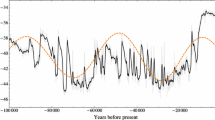Abstract
Based on a combined data set of sea surface temperature, zonal surface wind stress and upper ocean heat content the dynamics of the El Niño phenomenon is investigated. In a reduced phase space spanned by the first four EOFs two different stochastic models are estimated from the data. A nonlinear model represented by a simulated neural network is compared with a linear model obtained with the principal oscillation pattern (POP) analysis. While the linear model is limited to damped oscillations onto a fix point attractor, the nonlinear model recovers a limit cycle attractor. This indicates that the real system is located above the bifurcation point in parameter space supporting self-sustained oscillations. The results are discussed with respect to consistency with current theory.
Similar content being viewed by others
References
Barnett TP, Hasselmann K (1979) Techniques of linear prediction, with application to oceanic and atmospheric fields in the tropical Pacific. Revs Geophys Space Phys 17:949–968
Battisti DS (1988) The dynamics and thermodynamics of a warming event in a coupled tropical atmosphere/ocean model. J Atmos Sci 45:2889–2919
Battisti DS, Hirst AC (1989) Interannual variability in a tropical atmosphere-ocean model: influence of the basic state, ocean geometry and nonlinearity. J Atmos Sci 46:1687–1712
Cane MA, Zebiak SE, Dolan SC (1986) Experimental forecasts of El Niño. Nature 321:827–832
Cane MA, Münnich M, Zebiak SE (1990) A study of self-excited oscillations of the tropical ocean-atmosphere system. Part I: linear analysis. J Atmos Sci 47:1562–1577
Chao Y, Philander SGH (1991) On the structure of the Southern Oscillation and evaluation of coupled ocean-atmosphere models. TOGA Notes 3 (April): 1-8
Elsner JB, Tsonis AA (1992) Nonlinear prediction, chaos, and noise. Bull Am Meteorol Soc 73:49–60
Graham NE, White WB (1988) The El Niño cycle: a natural oscillator of the Pacific ocean-atmosphere system. Science 240:1293–1302
Hasselmann K (1988) PIPs and POPS: the reduction of complex dynamical systems using principal interactions and oscillation patterns. J Geophys Res 93:11015–11021
Latif M, Sterl A, Maier-Reimer E, Junge MM (1993) Structure and predictability of the El Niño/Southern Oscillation phenomenon in a coupled ocean-atmosphere general circulation model. J Clint 6:6701–6708
Münnich M, Cane MA, Zebiak SE (1991) A study of self-excited oscillations in tropical ocean-atmosphere system. Part 11: nonlinear cases. J Atmos Sci 48:1238–1248
Neelin JD, Jin FF (1993) Modes of interannual tropical oceanatmosphere interactions, a unified view. Part 11: analytical results in the weak coupling limit. J Atmos Sci 50:3504–3522
Philander SGH (1990) A review of simulations of the Southern Oscillation, International TOGA Scientific Conference Proceedings (Honolulu, Hawai, USA, 16-20 July 1990), World Climate Research Programme, WCRP-43, WMO/TD-No. 379
Rasmusson EM, Carpenter TH (1982) Variations in tropical sea surface temperature and surface wind fields associated with the Southern Oscillation/El Niño. Mon Weather Rev 110:354–384
Richman MB, Angel JR, Gong X (1992) Determination of dimensionality in eigenanalysis (preprint)
Rumelhart DG, Hinton GE, Williams RJ (1986) Learning representations by back-propagating errors. Nature 323:533–536
Schopf PS, Suarez MJ (1988) Vacillations in a coupled oceanatmosphere model. J Atmos Sci 45:549–566
Storch H von, Bruns T, Fischer-Bruns I, Hasselmann K (1988) Principal oscillation pattern analysis of the 30- to 60-day oscillation in general circulation model equatorial troposphere. J Geophys Res 93:11022–11036
Storch H von, Weese U, Xu JS (1990) Simultaneous analysis of space-time variability: principal oscillation and principal interaction patterns with applications to the Southern Oscillation. Z Meteorol 40:99–103
Widrow B, Lehr MA (1990) 30 years of adaptive neural networks: perceptron, madaline, and backpropagation. Proc IEEE 78:1415–1441
Zebiak SE, Cane MA (1987) A model El Niño-Southern Oscillation. Mon Weather Rev 115:2262–2278
Author information
Authors and Affiliations
Rights and permissions
About this article
Cite this article
Grieger, B., Latif, M. Reconstruction of the El Niño attractor with neural networks. Climate Dynamics 10, 267–276 (1994). https://doi.org/10.1007/BF00228027
Received:
Accepted:
Issue Date:
DOI: https://doi.org/10.1007/BF00228027




